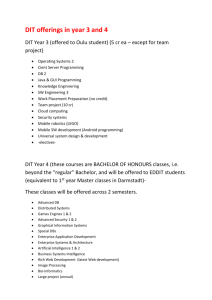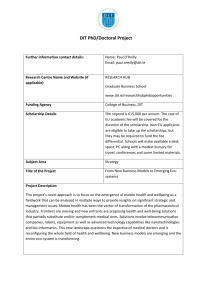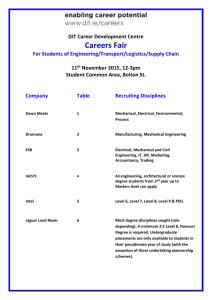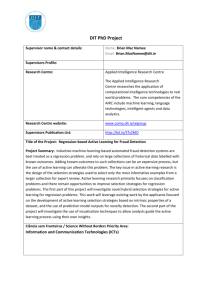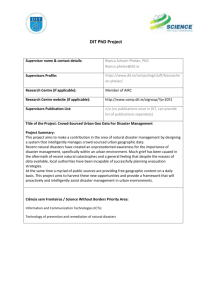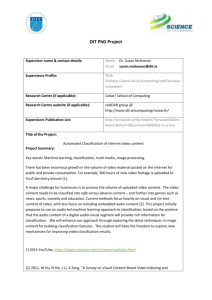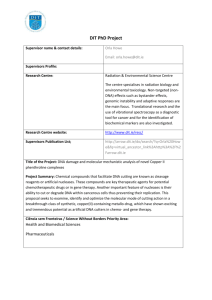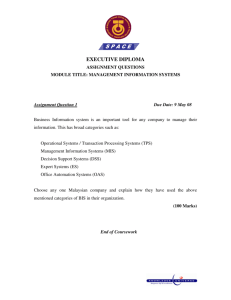Harvard Referencing Guide (DIT Library Kevin St)
advertisement
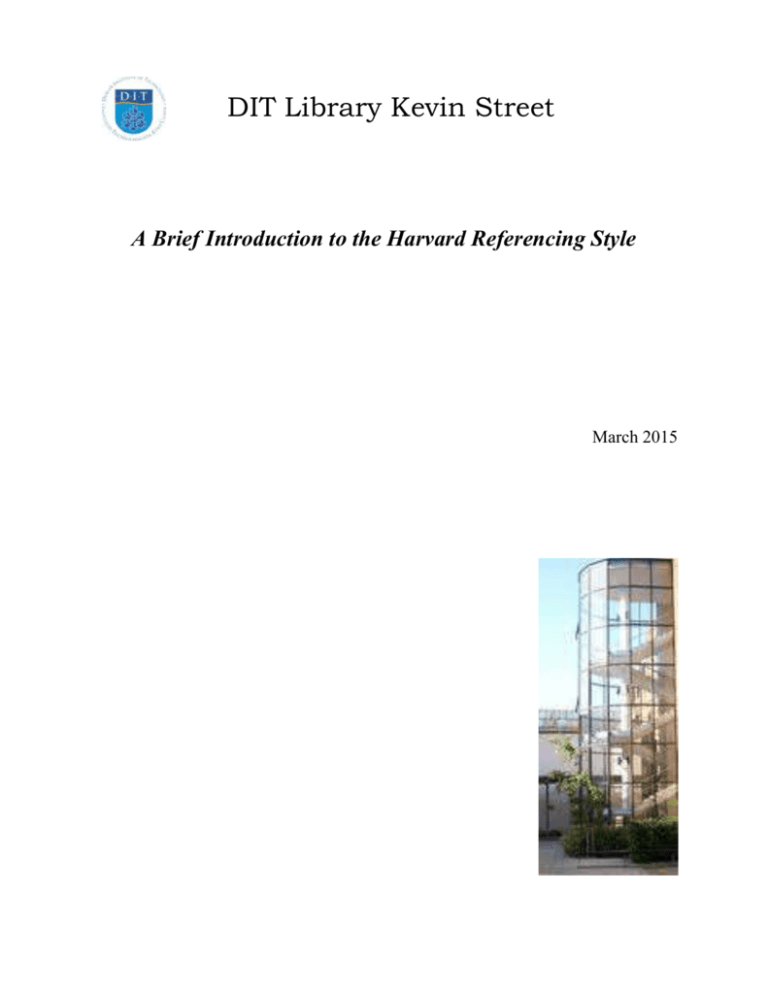
DIT Library Kevin Street A Brief Introduction to the Harvard Referencing Style March 2015 Why Do I have to Use a Referencing Style in my Assignment? You must use an approved referencing style at third level in order to (a) enable your readers to locate your sources (b) show the range of your reading and research and (c) avoid plagiarism. When you plagiarise you are passing another person’s ideas/theories off as your own. Therefore, all sources that you use in your assignment, whether quoted from directly, paraphrased or summarised must be acknowledged. Standard Academic Practice Which Referencing Style Should I use? There are various different referencing style guides in use at third level. You should check which guide is recommended by the College of Sciences & Health or the College of Engineering in Kevin St. This guide provides a brief introduction to the Harvard (Referencing style also known as Author/Date. It is based on (Williams and Carroll, 2009; Pears and Shields, 2013; University College Dublin Library, 2014). You should be aware that there are variations (Williams and Carroll, 2009, p.102) of the Harvard Referencing style, as there are in other referencing systems. You should therefore, pick one in consultation with your lecturers and use it consistently throughout your assignment. 2 What is the Harvard (author-date) Referencing Style? The Harvard (author-date) referencing style proscribes that, for every source used in an assignment, you must cite it in two places: 1. In the body of the text of your document (in-text citation). 2. In the Reference List at the end of the document. This is where you provide the source of the information in full. Only material cited in the body of your text should be included in the reference list. 3. All of the citation details for a printed book, like author, date of publication, can be found on the title page (front and back). Sample In-Text Citations Direct Quotation Use quotation marks when quoting directly from any academic source whether printed or e-book, print or e-journal article etc. In this case you are taking the words directly from the original source material (verbatim) without changing anything. Choose to use either single or double quotation marks for short, up to a maximum of three lines, direct quotations. • e.g. Knight argues that ‘A picture is one way to represent your knowledge of a situation’ (2013, p.21). A page number is required for lengthy or direct quotations. • Longer quotations are block indented from the left, as a separate paragraph, and indented from the main text of your assignment. You don’t need to use quotation marks here. • Type three dots [ellipsis] ... to indicate material omitted from the original source. Paraphrasing Here you aren’t quoting directly from the original source author, but summarising his/her ideas/theories in your own words. According to Knight (2013) knowledge can be represented in several ways... It has been suggested that knowledge (Knight, 2013)... However, if you are explaining a point from a particular page, then you need to include the page number (Williams and Carroll, 2009). 3 Book by One Author According to Knight (2013).... It has been contended (Knight, 2013)... Book by Two-Three Authors Banwell and McCash (1994) surmised that... It was reported by (Banwell and McCash, 1994) that... It was examined by (Martini, Nath and Bartholomew, 2015)... Books by More than Three Authors Pears et al. (2015) believe... It has been argued that (Pears et al., 2015)... Multiple Works by Same Author in Same Year When citing different works, often journal articles, by the same author published in the same year include the letters a, b, c etc in lower case after the date: (Martini 2001a) argues... He believes (Martini 2001b)... Corporate Author In this case the author is an organisation rather than an individual person Dublin Institute of Technology (2015) published... The following report concerning first year science students’ retention (Dublin Institute of Technology, 2015) highlights... No Author/Editor Use the title (in italics) of the book/report/article, as the author, instead and follow the rules for printed books above (Pears and Shields, 2013, p.15). Notably, reference items, like dictionaries and handbooks, don’t always have an “obvious author or editor” (Pears and Shields, 2013, p. 27). PDR Lab Advisor (2006) 4 Book with an Editor Cite the editor’s last name: The benefits of diet in pregnancy was examined in Gandy (2014) Various experts have considered the link between poor dietary practices and type 2 diabetes (Gandy, 2014). Chapter in an Edited Book Cite the author of the chapter, rather than the editor of the book: Pregnant women are advised by Rees (2014)... It has been suggested that (Rees, 2014)... Book in Translation You must reference ‘the translation you have read, not the original work’ (Pears and Shields, 2014, p. 24): Chekov (2005) captured Russian angst... An E-Book Follow the instructions/rules for printed books above. Note, that citing from books on a personal edevice like a Kindle or smart phone differs slightly as pagination details aren’t often available on these devices (Pears and Shields, 2014, pp. 22-23): (Willoughby, 2011, 50%). An article from a print journal Follow the instructions for printed books An article from an e-journal Follow the instructions for e-books A page on a website Webpage Author(s) Last Name (Year) Casselman (2015) described... The mathematics of the rainbow (Casselman, 2015) concerns... 5 Email Use the sender’s last name: Moran (2014) requested.... (Moran, 2014) A Dissertation/Thesis/Final Year Project Follow the instructions for books and journals above: Vassileva (2013) examines... Conference Proceeding Cited like a book chapter except the conference paper title replaces a chapter title and the conference title replaces the book title: Jones and Noble (2014) look at a programming language... Blogs DIT Library Kevin Street (2015) provided a list of forthcoming anatomy titles... Twitter Students are finding Bloom’s revised taxonomy (DIT Library Kevin Street, 2015) interesting.... Compiling a Reference List The reference list or bibliography contains the full citation details for each in-text citation. This will enable your readers to find your sources for themselves. The reference list should be in alphabetical order by surname/family name of the author, followed by the first name or initials as given in the work cited. Book by One Author Knight, R.D. (2013) Physics for Scientists and Engineers: a strategic approach with modern physics. 3rd edn. Boston: Pearson. Where the book is a first edition or no edition specified Plopper, G. (2013) Principles of Cell Biology. Burlington: Jones & Bartlett. 6 Book by Two Authors Banwell, C.N. and McCash, E.M. (1994) Fundamentals of Molecular Spectroscopy. 4th edn. London: McGraw-Hill. Book by Three or More Authors All of the authors are listed (Pears and Shields, 2013, p.25): Martini, F. A., Nath, J.L.and Bartholomew, E.F. (2015) Fundamentals of Anatomy & Physiology. 10th edn. Harlow: Pearson. Multiple Works by the Same Author in the Same Year List them in alphabetical order in the reference list; following the instructions for referencing a printed book/journal. Ensure that a letter follows the year Kotler, P (2015a) Corporate Author Name of corporate author (Year) Title. Place of Publication: Publisher. No Author PDR Lab Advisor (2006) Montvale: Thompson PDR. Book with an Editor Editor (s) Last name, Initials. (Ed.). (Year) Title. Place of publication: Publisher. E.g: Gandy, J. (Ed.). (2014) Manual of Dietetic Practice. 5th edn. Oxford: Wiley Blackwell. Chapter or Article in an Edited Work Rees, G. (2014) Preconception and pregnancy. In Gandy, J (Ed.) Manual of Dietetic Practice. 5th edn. Oxford: Wiley Blackwell. Book in Translation Chekov, A. (2005) In the Cart. Translated by R. Chandler. London: Penguin Books. An E-Book Bolton, W. (2011) Mathematics for Engineering [Online]. 2nd edn. Abingdon: Routledge. Available at: http://0-lib.myilibrary.com.ditlib.dit.ie/Open.aspx?id=386123 [Downloaded: 11 March 2015]. 7 Note: You can also include Digital Object Identifiers (DOIs) in your reference instead of a URL (Pears and Shields, 2013 pp. 16-17). A DOI is a unique alphanumeric string which provides a persistent link to online content. An Article from a Print Journal Petrarca, M. (2015)‘Ocular complications during pregnancy’. Optometry Today -Journal of the Association of Optometrists, 55 (3), pp. 46-50. An Article from an e-Journal Bjorkstrom, N K. and Kekalainen, E. and Mjosberg, J. (2013) ‘Tissue-specific effector functions of innate lymphoid cells’, Immunology, 139 (4), pp. 416-427. Available at: http://web.a.ebscohost.com/ehost/pdfviewer/pdfviewer?sid=400a70a4-640c-4976-ad3b4527ed212e08%40sessionmgr4003&vid=3&hid=4101 [Accessed 24 February 2015] Just as we have seen with E-Books above , you can also include Digital Object Identifiers (DOIs) in your reference instead of a URL (Pears and Shields, 2013, pp.16-17). A Page on a Website Casselman, B. (2015) The Mathematics of the Rainbow, Part II. Available at: http://www.ams.org/samplings/feature-column/fc-2015-02 [Accessed 24 February 2015]. An Email Moran, C. (2014) Email to Martin Murphy, 8 March. A Dissertation/Thesis/Final Year Project Vassileva, R. (2013) RNA interference of CTLA4 in human leukaemia T Cells. Unpublished PhD thesis. Dublin Institute of Technology. Conference Proceeding Author(s) Last Name, Initials (Year) ‘Title of paper’, Title of conference: subtitle. Location and date of conference. Place of publication: Publisher, Page numbers: Jones, T. And Noble, J. (2014) ‘Tinygrace: A simple, safe, and structurally typed language’, Proceedings for FTfJP 2014: The 16th Workshop on Formal Techniques for Java-Like Programs-Co-located with ECOOP 2014. Uppsala; Sweden, 28th July. 8 Blogs DIT Library Kevin Street (2015) ‘New my iLibrary ebooks for science and eng’, DIT Kevin Street Library blog, 16 March. Available at: http://ditlibrary-scienceblog.blogspot.ie/ (Accessed: 19 March 2015). Twitter DIT Library Kevin Street (2015) 19 March. Available at: https://twitter.com/KevinStLibrary (Accessed 19 March 2015). Citation Tools Various free online reference manager tools, like EndNote Basic, Zotero or Mendeley may be used in order to create your own in-text citations and reference list for your assignment. Further information on these tools may be found in the Kevin Street Information Guide No 8. See also: DIT Library Subject Guides: http://www.dit.ie/library/subjects/ Getting Started with Endnote Basic: http://dit.ie/library/endnote/ Suggested Reading NB: Books on citing and writing are in Kevin St Library Stack 10 starting at shelf number 808. DIT Library Kevin Street (2015) References & Citing Sources: Library Guide No. 8. Available http://www.dit.ie/media/library/documents/kevinst/Info%20guide%208A%20finding%20inform ation%20citations%20with%20endnote.pdf DIT Library Services (2014) Endnote Basic. Available at: http://www.dit.ie/media/library/documents/EndnoteWeb19112014.pdf Halpin, A. and Callaghan, L. (2015) DCU Library Guide to Harvard Style of Citing & Referencing. Available at: https://www101.dcu.ie/library/Citing&ReferencingGuide/player.html McMillan, K. and Weyers, J. (2013) How to Cite, Reference & Avoid Plagiarism at University. Harlow: Pearson. Neville, C. (2010) The Complete Guide to Referencing and Avoiding Plagiarism. 2nd edn. Berkshire: Open University Press. 9 Pears, R. and Shields, G. (2013) Cite Them Right: the essential referencing guide. 9th edn. Hampshire: Palgrave Macmillan. University College Dublin Library (2014) Harvard Referencing Style. Available at: http://www.ucd.ie/t4cms/Guide69.pdf [Downloaded: 23 February 2015]. Williams, K. And Carroll, J. (2009) Referencing & Understanding Plagiarism. New York: Palgrave Macmillan. 01-402-4894 kst.library@dit.ie or julie.defoubert@dit.ie @KevinStLibrary 10
